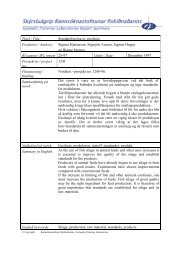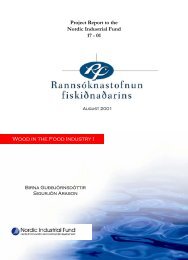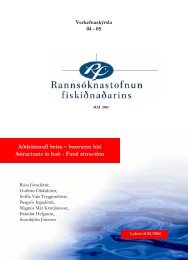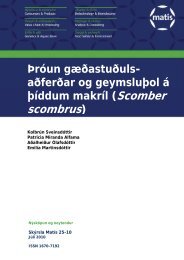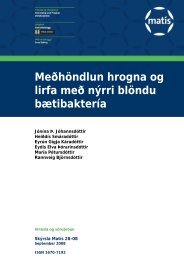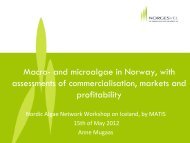Microbiology and Spoilage Trail in Nile Perch (Lates niloticus), Lake ...
Microbiology and Spoilage Trail in Nile Perch (Lates niloticus), Lake ...
Microbiology and Spoilage Trail in Nile Perch (Lates niloticus), Lake ...
You also want an ePaper? Increase the reach of your titles
YUMPU automatically turns print PDFs into web optimized ePapers that Google loves.
wash<strong>in</strong>g stage for fillets prior chill<strong>in</strong>g/freez<strong>in</strong>g is paramount important <strong>in</strong> order to reduce<br />
microbiological loads.<br />
5.3.2 Phase III – Trial 2: Shelf life of establishments chilled <strong>Nile</strong> perch fillets<br />
The estimates on storage time for chilled <strong>Nile</strong> perch fillets processed after long <strong>and</strong> short<br />
storage (10, 17, 6, & 5 days) of whole fresh <strong>Nile</strong> perch <strong>in</strong> ice from four establishments, E1-E4<br />
respectively was approximately 12, 8, <strong>and</strong> 10-13 days when the SSO/TVC counts reached 6-<br />
8 log10 cfu/g. The microbiological counts <strong>in</strong> long time (17 days) ice stored fish fillets were<br />
above the ICMSF-FAO/EU maximum guidel<strong>in</strong>es/limits (7 log10 cfu/g) after 8 storage days<br />
compared to the short time (5 days) ice stored fish which reached these counts after 10 -13<br />
days of storage (0-3 o C). The rate of spoilage has been reported be<strong>in</strong>g slow from sk<strong>in</strong> <strong>and</strong><br />
<strong>in</strong>creases for gutted, fillets <strong>and</strong> f<strong>in</strong>ally m<strong>in</strong>ced fish stored at chill conditions (ICMSF, 1980b).<br />
On the other h<strong>and</strong> long time storage of fish <strong>in</strong> ice allows growth of psychrotrophic bacteria<br />
(SSO) to big numbers, ICMSF, (1986) which def<strong>in</strong>itely reduce the shelf life of f<strong>in</strong>al processed<br />
fillets.<br />
Many studies have been published for the range of TVB-N values <strong>in</strong> <strong>Nile</strong> perch (Karungi et<br />
al., 2004). Many of these studies reported a concern that this parameter is not good <strong>in</strong>dicator<br />
for fish products freshness at ice/chill storage as <strong>in</strong> 5.2.2.2 laboratory chilled fillets above.<br />
This was also reported by Rehbe<strong>in</strong> <strong>and</strong> Olchlenschlager, (1982); Chytiri et al, (2004); Castro<br />
et al., 2006. The total volatile base am<strong>in</strong>e (TVB-N) produced dur<strong>in</strong>g later/advanced stages on<br />
chill/ice stored fish. Several authours have reported TVB-N value of ≤ 25mgN/100g for<br />
ra<strong>in</strong>bow trout, European sea bass <strong>and</strong> fresh Mediterranean fish (Chytiri et al., (2004); Castro<br />
et al., (2006); Kyrara <strong>and</strong> Lougovois, (2002) <strong>and</strong> Gimenez et al., (2002).<br />
5.3.2.1 Establishment E1 (10 days iced whole <strong>Nile</strong> perch)<br />
The storage life of fillets was approximately 12 days prior the beg<strong>in</strong>n<strong>in</strong>g of a rapid log<br />
phase with rapid <strong>in</strong>crease <strong>in</strong> the numbers of SSO, TVC <strong>and</strong> Enterobacteriaceae from 12-15<br />
storage days. It seems that the <strong>in</strong>crease <strong>in</strong> number of psychrotrophic bacteria (SSO, TVC) is<br />
relatively slow <strong>in</strong> the first 2 weeks at chill storage (0-3 o C). In this trial a common trend was<br />
observed to the laboratory chilled fillets trial <strong>in</strong> that both studies gave similar counts<br />
65




